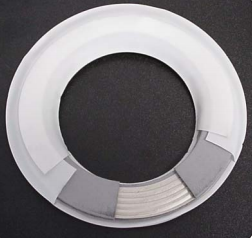Gasket Options for Glass-Lined Vessels
 Upon first glance, a gasket may appear to be an inconsequential part in a robust reactor system, but the job of this component is critical to the successful operation of your vessel. The role of a gasket is to create a tight seal between two components to prevent the unwanted emission of liquid or gas. Failure to do so can be catastrophic to your operation!
Upon first glance, a gasket may appear to be an inconsequential part in a robust reactor system, but the job of this component is critical to the successful operation of your vessel. The role of a gasket is to create a tight seal between two components to prevent the unwanted emission of liquid or gas. Failure to do so can be catastrophic to your operation!
The extreme temperatures and pressures under which glass-lined vessels often operate make it imperative that you select the right kind of gasket to withstand the specifications of your process.
Since compression is required to maintain the seal, gaskets are typically made with a malleable material, such as PTFE (polytetrafluoroethylene). A supple material like this is able to more effectively create a seal between the harder surfaces of the components it is placed between than a gasket made from rigid material, such as stainless steel.
PTFE is the most commonly used fluoropolymer for gasket construction. Its inertness and superior chemical resistance make it a choice material throughout a variety of industries. The rigorous operating conditions of glass-lined equipment make PTFE an ideal gasket selection due to its chemical properties, low coefficient of friction, and outstanding temperature resistance.
Glass-Lined-Steel Sealing Challenges
We’ve talked a lot in previous posts about the benefits of glass-lined steel (for those of you that aren’t familiar with this type of equipment can read our post entitled 5 Reasons your Process Could Benefit from Glass-Lined Steel Equipment or download our Introduction to Glass-Lined Steel Equipment eGuide). The composition and properties of glass-lined steel make it a desirable material of construction for processes that involve aggressive media that operate under severe conditions. These same harsh demands on this equipment can make it challenging to maintain a tight, lasting seal primarily due to limitations on gasket loads and fluctuations in the sealing surfaces. And these sealing challenges increase as flanged connections get larger in diameter. That is why it is important to make sure you are using the proper gasket for a given application. Failing to do so can lead to premature gasket failure, with consequences that range from problematic to catastrophic, including:
- Leakage/emissions
- Equipment damage
- Production downtime
- Risks to personnel safety
Sealing Solutions
There are a number of different gasket solutions. Depending on the size of the flange and service conditions of the equipment, there might be a solution that is more effective for one scenario than another. In this post we’ll review the different types of PTFE gaskets available and their utilization.
Unfilled PTFE Gaskets
Gaskets made of 100% PTFE are referred to as unfilled PTFE. Unfilled PTFE gaskets are quite versatile and can be used in most general applications. Within this category are two classifications: Virgin grade PTFE is a soft, formable material that is made directly from the resin producer, giving it the highest physical properties and resistance to creep (the frequently used term that refers to compression under load). Mechanical grade PTFE is still 100% PTFE but it is made from reprocessed resin so it’s not suited for high-purity or food applications. Typically virgin grade can be recognized by its whiter color when compared with mechanical grade.
Filled PTFE Gaskets
Filled PTFE gaskets include additives whose material helps to expand the performance of the gasket, enhancing its physical and chemical properties. Due to the improved mechanical strength over virgin PTFE, filled PTFE gaskets are the most widely used for industrial applications. The three main types of filler that are used in this style are:
- Carbon: Ranging in amount from approximately 10-35%, carbon filler increases compressive strength and can improve conductivity while still providing good chemical resistance. Carbon additives also help to increase the hardness and can improve the wear properties of the gasket.
- Graphite: Beneficial in hydraulic/pneumatic compression type seals and rotary applications, the addition of graphite to a gasket (approximately 5-15%) reduces the coefficient of friction and increases strength when compared to unfilled PTFE models.
- Glass: The addition of fiberglass in increments of 5-40% effectively increases the compressive strength of the gasket, increasing wear and reducing creep. This type of gasket is useful in applications that require a reduction in cold flow, which can be an issue with PTFE. The addition of glass doesn’t negatively affect the chemical and electrical properties of virgin PTFE. Protection rings that are used on larger manway openings are usually made in this construction.
PTFE Envelope Gaskets
Envelope gaskets feature virgin PTFE enclosures that offer protection to insert rings, which are made of a highly compressible, liquid-resistant material. These asbestos-free gaskets include a corrugated metal ring made of stainless steel, for long life in most services (a special benefit in corrosive atmospheres). Alternative materials of construction are available, such as monel and hastelloy. Additional features like grounding tabs for antistatic use or retaining clips to assist in retaining gaskets on manways and handholes. Different design options are also available, including:
- Single Envelope Gaskets: Designed for both small and larger nozzles, the virgin PTFE slit envelope is constructed of formed tape with a smooth, butt-welded junction (especially important for high-vacuum service). This envelope is used to protect the compressible inserts from the process environment. There are a lot of different envelope gaskets available, so it is important to make sure you are purchasing one that is appropriate to use with glass-lined equipment.
- Double Envelope Gaskets: This is similar to the single-envelope, except that a second envelope is used to “enclose” the entire gasket. The inner envelope protects the process side while the outer envelope protects from any atmospheric contaminants. A virgin PTFE slit type or butt-welded type envelopes are used to fully encapsulate the gasket from both the process side and the atmospheric side of the joint. Again, it is critical to ensure you are using a design suitable for glass-lined equipment.
- U-cut Gaskets: A multi-purpose U-channel gasket is an exceptionally high quality gasket for normal service applications on all glass-lined and alloy process equipment where PTFE is compatible with the product and process operating conditions. Instead of a butt-welded envelope, this design incorporates an envelope that is machined from a solid piece of PTFE, eliminating the need for any welds in the fabrication. The U-cut design combines a unique convex geometry to allow the gasket to conform more uniformly to the compressive forces when the nozzle bolts are torqued, making it highly attractive for food and pharmaceutical applications where product build-up is not acceptable and CIP is required.
For even more information, download a copy of our Gasket Portfolio, that contains specs and part numbers for our most popular envelope gasket designs.
ePTFE Tape
Expanded PTFE is created by rapidly stretching PTFE under the right conditions to create a very strong, microporous material. The resulting material, known ePTFE, exhibits the array of properties found in virgin PTFE, such as strength, chemical inertness, and high thermal resistance.
ePTFE is much softer and more flexible than regular PTFE, giving it the ability to be manufactured into tape that can be fitted and installed onto a flange with an end product similar to how a traditional gasket would function. The added benefits of ePTFE tape are ease of compression, minimal creep and cold flow, and the ability for on-site customization (which eliminates the long lead times and complicated logistics that are brought about by offsite shipping, handling and installation).
Gasket and Torque Requirements
A gasket is only as good as its compression, so proper bolt torquing is essential to provide consistent sealing. If your gasket is under-compressed it will be prone to leaks (and for users of glass-lined equipment that can often equate to leakage of a highly corrosive product!). Under compression also creates risk of entrapment areas between the gasket and flange, which are not only dangerous, but they make cleaning difficult. On the flip side, over compression produces high stresses on the gasket material, clamps, and flanges which can lead to damage or premature failure.
By controlling the torque applied to the gasket clamps, you can achieve correct compression during initial installation. The correct torque setting depends on the gasket material. Generally after the final torque is reached a re-torque should be done after the first heat cycle or 24 hrs. For more detailed procedures, instructions, and recommendations on bolting torques for our AFII gaskets, consult Section V of our Glass-Lined Equipment Maintenance Manual.
PTFE’s unique properties and unmatched versatility make it a popular choice of gasket construction in many industrial applications, particularly in chemical processes that involve aggressive media and require high-purity conditions. Unfilled PTFE, filled PTFE, and ePTFE tape are all viable choices and offer distinctive advantages based on different process conditions. Factors such as flange size, operating pressure and temperature will help to determine which type will perform the best for you. If you have questions or need assistance pertaining to sealing issues specific to your glass-lined steel equipment, download our Gasket Portfolio, contact the DDPS Aftermarket Department at 908-317-2585, or submit a form online and we will get back to you with more information concerning your inquiry.
